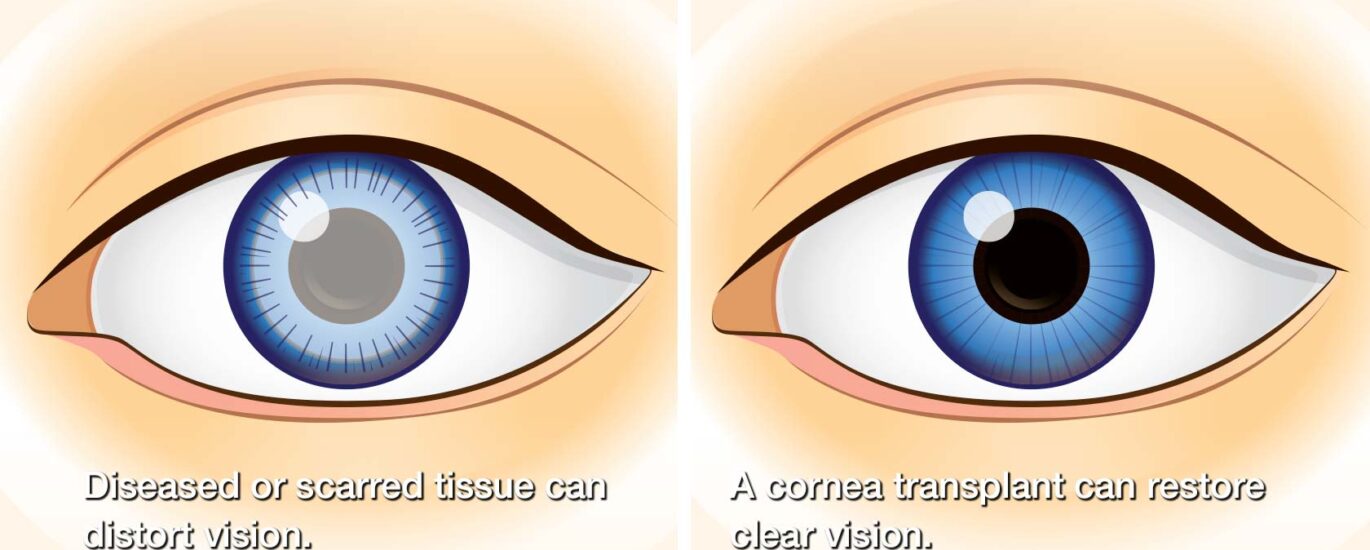Introduction
Vision is one of the most precious senses we possess. The ability to see the world around us, to read, and to recognize faces, is something we often take for granted. But for some, this gift is impaired by corneal diseases or injuries, leading to vision loss. Enter the life-changing corneal transplant procedure. Let’s dive deep into what happens during this remarkable surgery.
Understanding the Cornea
Structure and Function of the Cornea
The cornea is the clear, dome-shaped surface that covers the front of the eye. It plays a crucial role in focusing your vision. Acting like a window, it helps to refract or bend light, enabling us to see clearly.
Common Corneal Diseases
Several conditions can affect the cornea, including keratoconus, Fuchs’ dystrophy, and corneal scarring from infections or injuries. These conditions can lead to blurred vision, pain, and even blindness.
Why Corneal Transplants Are Necessary
Indications for Corneal Transplant
A corneal transplant is often recommended when the cornea is too damaged to repair with other treatments. This might be due to diseases like keratoconus, Fuchs’ dystrophy, or severe infections and injuries.
Benefits of the Procedure
Corneal transplants can restore vision, reduce pain, and improve the appearance of a damaged or diseased cornea. For many, it’s a transformative procedure that significantly enhances the quality of life.
Types of Corneal Transplants
Penetrating Keratoplasty (PK)
PK is a full-thickness transplant where the entire damaged cornea is replaced with a healthy donor cornea.
Endothelial Keratoplasty (EK)
EK is a partial-thickness transplant focusing on the innermost layer of the cornea, often used for diseases affecting the endothelium.
Deep Anterior Lamellar Keratoplasty (DALK)
DALK involves replacing the front and middle layers of the cornea, preserving the healthy endothelium.
Pre-Surgery Preparations
Medical Evaluation
Before the surgery, a thorough medical evaluation is essential. This includes a detailed eye examination and tests to ensure you are a suitable candidate for the procedure.
Preparing Mentally and Physically
Being mentally and physically prepared can significantly impact the outcome. Discuss your concerns with your doctor, and follow pre-operative instructions carefully.
The Day of Surgery
Arrival at the Hospital
On the day of surgery, you’ll arrive at the hospital or surgical center. You’ll be guided through the admission process and pre-operative checks.
Pre-Operative Procedures
Pre-operative procedures include administering eye drops, cleaning the eye area, and starting an IV line for medications.
Anesthesia Options
Local Anesthesia
Local anesthesia numbs the eye area while keeping you awake. It’s often combined with sedation to help you relax.
General Anesthesia
General anesthesia puts you into a deep sleep during the surgery. It’s typically used for patients who may be anxious or for complex cases.
Choosing the Right Option
Your surgeon will discuss the best anesthesia option for you, considering your medical history and personal preferences.
The Corneal Transplant Procedure
Step-by-Step Process
- Incision: The surgeon makes a precise incision in the cornea.
- Removal: The damaged corneal tissue is carefully removed.
- Replacement: The donor cornea is placed and sutured into position.
- Final Adjustments: The surgeon makes any necessary adjustments to ensure a perfect fit.
Role of the Surgeon and Medical Team
The surgeon, supported by a skilled medical team, ensures the procedure is performed with precision and care.
Post-Surgery Care
Immediate Post-Operative Care
After the surgery, you’ll be taken to a recovery area. Your eye will be covered with a protective shield, and you’ll be monitored closely.
Medications and Eye Drops
You’ll receive medications and eye drops to prevent infection and reduce inflammation. It’s crucial to follow the prescribed regimen.
Recovery Process
Short-Term Recovery
In the short term, you’ll need to rest and avoid strenuous activities. Follow-up visits with your doctor are essential to monitor healing.
Long-Term Recovery and Healing
Long-term recovery involves gradual improvement in vision. It can take several months for your vision to stabilize fully.
Potential Risks and Complications
Common Complications
Complications can include infection, rejection of the donor cornea, and issues with the stitches. However, these are relatively rare.
How to Mitigate Risks
Following your doctor’s instructions, attending all follow-up appointments, and reporting any unusual symptoms promptly can help mitigate risks.
Success Rates and Outcomes
Statistics and Success Stories
Corneal transplants have high success rates, with many patients experiencing significant vision improvement. Success stories abound, highlighting the procedure’s impact.
Factors Influencing Success
Factors influencing success include the patient’s overall health, the severity of the initial condition, and adherence to post-operative care.
Patient Experiences
Testimonials and Personal Stories
Hearing from those who have undergone the procedure can be encouraging. Many patients report life-changing improvements in their vision and quality of life.
Emotional and Psychological Impact
The emotional and psychological impact of restored vision can be profound, boosting confidence and overall well-being.
FAQs
- How long does a corneal transplant take?
- The surgery typically takes one to two hours, but you should plan for a longer hospital stay for preparation and recovery.
- The surgery typically takes one to two hours, but you should plan for a longer hospital stay for preparation and recovery.
- Is the procedure painful?
- You won’t feel pain during the surgery due to anesthesia. Post-surgery, you may experience discomfort, which can be managed with medications.
- You won’t feel pain during the surgery due to anesthesia. Post-surgery, you may experience discomfort, which can be managed with medications.
- How long before I see improvement in my vision?
- Vision improvement can start within a few weeks, but full recovery and stabilization can take several months.
- Vision improvement can start within a few weeks, but full recovery and stabilization can take several months.
- What are the signs of corneal transplant rejection?
- Symptoms of rejection include redness, sensitivity to light, vision loss, and pain. Contact your doctor immediately if you notice these signs.
- Symptoms of rejection include redness, sensitivity to light, vision loss, and pain. Contact your doctor immediately if you notice these signs.
- Can I return to normal activities after surgery?
- You’ll need to avoid strenuous activities for a few weeks. Your doctor will give you specific guidelines on resuming daily tasks.
- You’ll need to avoid strenuous activities for a few weeks. Your doctor will give you specific guidelines on resuming daily tasks.
Conclusion
Corneal transplants are a beacon of hope for those suffering from severe vision impairment. By understanding the procedure and its impact, patients can approach surgery with confidence and optimism. This transformative surgery not only restores sight but also enriches lives, opening up a world of possibilities.





One thought on “The Corneal Transplant Procedure”